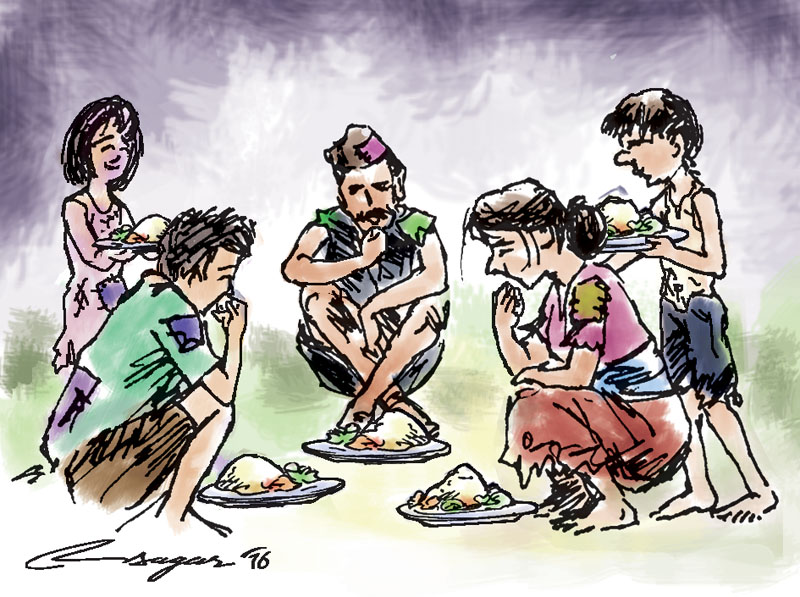Hunger and poverty: Top national agenda
There seems to be a growing realization in Nepal and elsewhere that sustainable development in agriculture requires a multisectoral approach, one that brings together the public and private sectors and the active participation by local and indigenous communities
The devastating earthquakes that struck Nepal last year served as a tragic reminder of the country’s vulnerability to natural disasters. Yet the brave response of the worst-hit populations, including many family farmers and rural communities, is emblematic of how determined the Nepalese people are in the face of adversity.
It is with similar determination and courage that Nepal has put hunger and poverty eradication at the top of the national agenda. First the country enshrined the “right to food” in its constitution and it is now launching the National Action Plan 2016-2025 under the Zero Hunger initiative.
High level political will and commitment are fundamental if we are to defeat hunger and all forms of malnutrition. And we also have to be ambitious, setting our sights high to achieve a better future that leaves no one behind.
Nepal’s National Plan is in line with the set of 17 Sustainable Development Goals (SDGs) adopted by the international community last year, in particular with SDG 1, eradicating poverty, SDG 2 ending hunger and malnutrition and SDG 13, taking action to combat climate change and its impacts.
Nepal has made considerable progress in recent years on many of these themes which are at the heart of the global 2030 Agenda for Sustainable Development. The country, for example, has achieved one of the fastest reduction rates in child stunting in the world, from 57 per cent to less than 41 per cent in 10 years, while undernourishment has been reduced by almost 10 per cent.
Still, eradicating hunger by 2025, as stated in the National Action Plan, represents a huge challenge. FAO will continue to support the Nepalese government and development partners including civil society organizations to reach this and other targets.
There seems to be a growing realization in Nepal and elsewhere that sustainable development in agriculture requires a multisectoral approach, one that brings together the public and private sectors and the active participation by local and indigenous communities.
And it also involves much more than increased food production. Hunger continues to afflict around 800 million people in the world, and this is largely due to a lack of access to food and inequality in the distribution of resources, including land and water, and of course, access to markets.
Nepal’s National Action Plan 2016-2025 is designed to take all this into account. Its focus extends beyond food production, to encompass principles of sustainable food security and nutrition, which include making access more fair, promoting rural development, ensuring the rights of family farmers, especially women and youth, and reducing food losses and waste.
The message here in Nepal is clear: we need to transform farming and food systems across the value chain, from production, distribution and consumption side.
By 2050, the population of the world is expected to top 9 billion – this means finding ways to support an additional 2 billion people with existing resources. In this context, climate change adds a further challenge through the increase of extreme weather events such as droughts and floods.
Nepal faces specific hurdles in achieving food security mainly due to difficult natural conditions, limited market access and the subsistence nature of agricultural practices. Given that agriculture is the primary source of livelihoods for close to two thirds of its population, investment in this sector is one of the best ways for Nepal to uplift that one-quarter of its population that currently lives below the national poverty line.
During the recent FAO Regional Conference for Asia and the Pacific, I highlighted the importance and the benefits of social protection which, together with private sector investments in the rural economy, has been identified as key to eradicating hunger and extreme poverty.
Through direct income support to the most vulnerable households, social protection combines short term and long term measures enabling poor people to achieve food security while also contributing to improve agricultural productivity and nutrition and encourage the sustainable use of natural resources.
As the people of Nepal know too well in the aftermath of last year’s earthquakes, the rural poor are the most vulnerable to food insecurity and malnutrition, and they are also the least equipped to deal with the impact of natural disasters. They must be helped to adapt to shocks, including climate change, in order to build resilience and safeguard their livelihoods. This must be the foundation stone to promote a peaceful and inclusive society.
The writer is Director General of Food and Agriculture Organization of the United Nations






